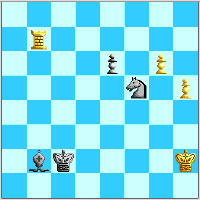
Position after 45. Kh2. Black's Bishop and King get tangled.
An interesting position was reachable from 38. Rd1 b2 39. g6 Kc4 40. Bxd6!? (40. h6! is the quicker win) Bg7 41. Ba3 Kb3 42. Bxb2 Bxb2 43. Rd7 Nf5 44. Rxb7+ Kc2 and now 45. Kh2 was given as "+/-". White avoided 45. Kg2!? owing to 45...Ng7! with a saving check after 46. h6 Nf5, or 45. Rh7 Kd3 46. h6 Ke4 47. g7 Nxh6! with an instant draw. That White is winning with 45. Kh2! needs some elaboration:

Position after 45. Kh2. Black's Bishop and King get tangled.
C1) 45...Be5+ 46. Kh3 Kd3, and now:
C11) 47. Kg4, and White's point is:
C111) 47...Ke4 48. Rb4+(!) (48. Kg5?! Bc3, and it appears that Black can just sit) Ke3 (48...Kd5 49. Rb5+ Ke4 50. Rxe5+! Kxe5 51. Kg5!+/- is half of the point) and now can White break through? It appears so: 49. Rb6 Nh6+ 50. Kg5 Bf4+ 51. Kf6 e5 52. g7 e4 53. Kg6 Ke3 54. Kh7! is seen as +/- by MacChess 5.0.1. Other indications of Black's problems are:
C112) 47...Kd4 48. Kg5!, and Black is blocked from playing the Bishop to a square that can prevent 49. h6 with a check&emdash;also since 48...Ke3 49. Rb5 Bg7 50. Rxf5! exf5 51. Kxf5! wins,
C113) 47...Kc4!? 48. Kg5 Bd4 49. Rc7+!, and since 49...Kd3/d5 50. Rd7(+) is fatal in the short run, Black must play 49...Kb5, but 50. Rc8 underscores that Black cannot ultimately save the e-pawn, and the position falls.
Black trickiest try seems to be:
C114) 47...Bf6!? playing to keep White's King out. White has several attractive replies:
C1141) 48. Rb6 Nh6+ 49. Kf3! Nf5 50. Kf4, when however Black can save the pawn by 50...Bd4! as 51. Rxe6 Ng7 is sheer luck for Black.
C1142) 48. Kf4(!) is chosen by MacChess, and owing to the threat of 49. Rf7 and the inability of Black's Bishop to move, MacChess' reply 48...Nh6 is probably forced (48...Kd4 49. Rf7 Be5+ 50. Kg5 looks +/-). Now 49...e5+ is a threat, so 49. Rd7+ looks called for, and Black's king has a choice:
C11421) 48...Kc4 49. Rh7 Nf5 (49...Bb2 50. Rxh6 Bc1+ 51. Ke5 Bxh6 52. Kxe6+/-) 50. Rf7 Bb2 51. Rxf5+/-.
C11422) 48...Ke2 is chosen by MacChess, and at 4 billion nodes from 47. Kg4 it gave the principal variation as 49. Rh7 Nf5 50. Ra7(?) Kd3 51. Ra6 Bd4! 52. Ra3+ Kf2 53. Ra2+ Kf1 (huh?) 54. Rh2 "+220". But after 49. Rh7 Nf5 (49...e5+? 50. Ke4+/-; 49...Bc1? 50. Rxh6! Bc1+ 51. Ke5 Bxh6 52. Kf6!+/-) it sees 50. Rf7! winning hands-down. Hence Black appears lost with 45...Be5+.
C12) 47. Rb4, cutting off Black's King, may also win, but Black can keep White out by 47...Nh6, when 48. Rb6 Ke4 49. Rxe6 Kf5 wins the e-pawn but not the game. It seems that 47. Kg4 is the most accurate way.
What now comes to light is that Black's real problem is that her Bishop has no good squares along the long diagonal! White has finally dominated the beast. The other tries seem to meet these fates:
C2) 45...Bd4 46. Kh3 (46. Rd7!?) Kd3 47. Kg4 Ke4, and Black's problem is that 48. Rb4! is deadly here as well.
C3) 45...Bc3!? and now:
C31) 46. Rb6 Kd3! and now:
C311) 47. Rxe6? Ng7 48. Rd6+ Ke4 49. h6 Be5+! 50. Kh3 Nf5=.
C312) 47. Rb3?! Kc4! and 48. Rxc3+ Kxc3 49. Kh3 Nh6 50. Kh4 e5 51. Kg5 e4 52. Kxh6 e3 53. g7 e2 54. g8=Q e1=Q is EGTB=.
C313) 47. Kh3 Ke4! 48. Kg4 (48. Rxe6+ Kf4 is nothing for White) Ke5! looks uncrackable.
C32) 46. Rd7(!) and now:
C321) 46...Kb3 47. Kh3 Kc4 48. Rc7+ Kd3 49. Rxc3+ is +/-.
C322) 46...e5 47. g7, and now both 47... Nxg7 48. Rxg7 (48. h6 Ne6! doesn't work) e4 49. Re7 Kd3 50. Kg2 and 47...Nh6 48. Rd6! e4 49. Rxh6 Bxg7 50. Re6 are one tempo too late.
C4) 45...Ba1, and now:
C41) 46. Kh3?! Kd3 47. Kg4 Ke4 is Black's idea, when 48. Kg5 is safely answerable by 48...Bc3. This line is unclear. However:
C42) 46. Rb6 forces 46...Bc3. Black's idea (besides 47. Rxe6? Ng7) is that 47. Rd6 is now not possible, but simply 47. Kh3! is a mini-Zugzwang where any Black King or Bishop move makes the e-pawn takable. Since Black's Knight can't move either, Black is down to 47...e5, but 48. g7 Nxg7 49. h6 Nh5 50. h7 e4 51. Rc6 Nf4+ 52. Kg4 is a fancy way to win, and 48. Rf6 Nh6 49. g7 e4 50. Rxh6 Bxg7 51. Re6, a more prosaic way.
C43) 46. Rd7(!) exposes a flaw of 45...Ba1 more thematically: 46...Kc3 blocks the Bishop's coverage of g7, so Black's King cannot advance.
Finally, not counting 45...Bf6? 46. Rf7 Be5+ 47. Kh3 Nh6 48. Re7 Kd3 49. Rxe6 Kd4 (49...Ke4 50. g7 Ng8 51. Re8 Kf5 52. Rxg8 Kg5 53. Rc8 Bxg7 54 Rc5+ +/-) 50. Kh4 Kd5 51. Rxd5+ +/-, or 50...Bg7 51. Kg5+/-), there is
C5) 45...Bh8!?, and now:
C51) 46. h6 Nxh6 47. Rh7 Ng4+ 48. Kg3 Ne5 doesn't work.
C52) 46. Rf7!? Nh6, and now White can eschew the Pawn grab by 47. Re7 Kd3 48. Rxe6 Kd4 (unclear), and play 47. Rh7! Be5+ 48. Kh3 Ng8 (48...Nf5 49. Rd7! transposes into a better version of C111) 49. Rb7, though this is not entirely clear after 49...Kd3.
C53) 46. Rd7! is the thematic answer. The point is that on 46...Kc3 47. Kh3!, the threat of 48. h6 forces Black's Bishop to move again, thus defeating Black's hope to save a tempo over other lines.
That R+2P should beat B+N even when Black's King can come to the center is rather sobering, and this position and theme of chasing down Black's Bishop may well arise in real games.